Some of the Joys of Working with the RAS Collections
Some of the joys of working with historic collections are that you never know what you will need to research in any one week. As enquiries come in via email and researchers come to use the Reading Room, we can be asked questions about any part of the collections or be asked to find items that may have not been used for many years. The summer is a busy time for us, when academics have chance to travel to undertake their own research, and the Reading Room has been at full capacity on occasions. Between helping researchers I’ve continued working with the Collections loans material (not the Pankhurst Papers as it turns out) and have now catalogued the material to 1990. It’s interesting to see how often certain items in the collections were requested for loan particularly our manuscripts, both Persian and Malay, though most recently I catalogued the papers for the loan of five portraits: the James Wales’ portrait of Madhu Rao Narayan, the Maratha Peshwa, with Nana Fadnavis (RAS Head cat. 01.014); the portraits of Jamsetjee Bomanjee and Jamsetjee Nourojee, the Parsi shipbuilders (RAS Head cat. 01.007 and 01.008) by James Dorman; ‘An officer of Colonel Gardner’s Irregular cavalry’ (RAS Head cat. 015.067) by Jairam Das; and a ‘Cotton Printer Block Printing a Length of Fabric’ (RAS Head cat. 059.031) by an unknown Punjabi artist. These were all requested by the National Portrait Gallery, London, for an exhibition in 1990-1991. All are fantastic portraits, so below I’ve recreated our portion of the exhibition:
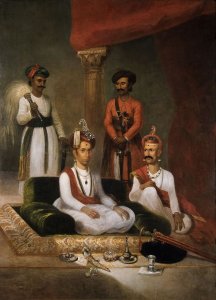
This oil painting is 228.6 x 190.4 cm and currently takes pride of place in our Reading Room. It was painted by James Wales in 1792, commissioned by the Peshwa shortly after Wales’ arrival in Pune. It is a masterful painting and well worth a close scrutiny to see the delicacy of the decoration of the jewellery, weapons and other items. Sadly this reproduction does not to justice to Wales’ skill.
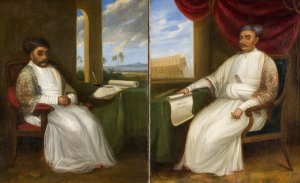
These oil paintings were undertaken by J. Dorman, an unknown artist operating in Mumbai. It is thought that they were created around 1830 which means the portrait of Jamsetsee Bomanjee must have been painted posthumously. The entry for this portrait in the Society’s catalogue, written by Raymond Head, suggests that it was based on an engraving made in 1812 after an original miniature by the artist Edward Nash. These portraits in more recent history were on long-term loan to the Museum of London but were returned to the Society in 2023 and are currently resting from being on display.
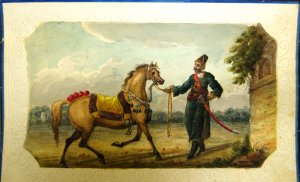
This watercolour painting is part of an album (23.6 x 15.2cm) of drawings and watercolours illustrating costumes, customs, castes and trades of India, created by Jairam Das of Patna, Bihar, c.1818. Of the album only four are watercolours but all are created on papers with impressed classical borders. They are part of a collection of artwork donated by Sir Charles D’Oyly. Jairam Das worked with D’Oyly on the production of the periodical ‘The Behar Lithographic Scrapbook’.
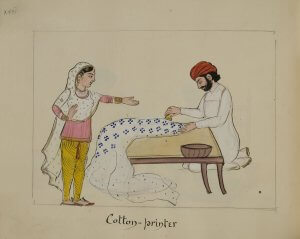
The painting of the cotton printer is part of another album (16.2 x 21 cm) in the Society’s collection. This consists of 98 images depicting monuments of Lahore, Amritsar, Delhi and Agra, rulers, princes and warriors of the Punjab, and trades and occupations. These were undertaken by a Punjabi artist working in Lahore c.1890. They were purchased by Henry C. Fanshawe, an Indian civil servant, in 1896 and bequeathed to the Society in 1923.
Alongside working on the Collections material this week, among other things, I’ve also needed to research and provide images of the Society’s medals; provide further information on RAS COLL3/1/2/1, a letter from Benjamin Clough accompanying the Pali book, ‘Pansiyapanas Jatakaya’, donated by Alexander Johnston; and discover more about Henry F.W. Holt, who, it seemed, had been a Secretary of the Society in the 1880s. This proved to be quite intriguing. From ‘A History of the Royal Asiatic Society, 1823-1973’ by C.F. Beckingham in The Royal Asiatic Society: Its History and Treasures edited by Stuart Simmonds and Simon Digby, Henry Holt is listed as sharing the Secretary and Librarian roles with William Sandys Wright Vaux, the numismatist and antiquarian, who worked in those roles from 1876 until his death in 1885. Though they are listed as sharing the roles from 1881-1885 the Council Minutes reveal otherwise. When Vaux died, a sub-committee was set up to review the role of the Secretary. Among their decisions regarding pay and conditions there is a minute which reads:
‘The late private Secretary of Mr Vaux will be retained to carry on the correspondence, and complete the Library catalogue at a cost of 1.1.0 per week’ (1 July 1885)
Thus is appears that Holt had been employed by Vaux to help with the work. This included Holt’s Catalogue of Chinese Manuscripts in the Library of the Royal Asiatic Society which was published in the 1890 Journal. Holt also published Notes on the Chinese Game of Chess in the Journal of the Royal Asiatic Society, (July 1885), pp. 352-365. He also produced A Catalogue of the Robert Morrison Chinese Library deposited at the University of London. In both catalogues each entry was given a Chinese and English title plus a small description in English. Thus it seems, Holt was very able in his duties.
The sub-committee met again in October 1885 and drew up a list of six names of people they considered suitable for the post: Dr S. Beal, Mr Henry Bradley, Mr H.F.W. Holt, Mr Stanley Lane Park, Professor Rhys Davids and Mr C.E. Wilson. Holt was therefore being considered to continue in the role. However, when it came to the Special Meeting of the Council on 2 November 1885 to consider the appointment of the Secretary, the President, Colonel Sir Henry Yule, proposed and the Director, Sir Henry Creswicke Rawlinson, seconded that the position should go to Sir Frederick Goldsmid! And that is what happened, though in reality he only held the position for a year before it passed to T.W. Rhys Davids who held it from 1887-1905.
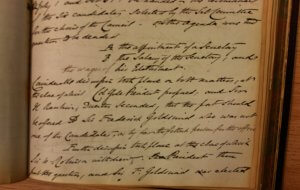
The only other biographical details we have for Holt are that he was the Acting Interpreter, Agent and Assistant at the Ningpo Consulate in 1864. It seems he was in China till 1876 – our membership lists show him in China in 1876 but in London in 1877. His name appears in the 1885 membership list but not beyond that. He disappears from our records at this stage.
Alongside answering these enquiries we have also had people in researching our Persian manuscripts, Punjabi history, the Society of Biblical Archaeology, our Chinese Special Collections, and the Society’s institutional records. We also had a visit from an archive and library apprentice at the Wellcome Trust, keen to discover more about the Society and broaden her knowledge about organisations working with historic collections. So, it has been another interesting week working with the Collections. I will wait to see what next week brings.

